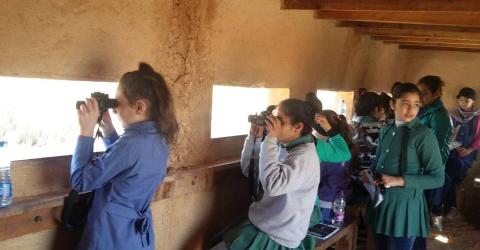
Managing Ramsar Sites
Contracting Parties are expected to manage their Ramsar Sites so as to maintain their ecological character and retain their essential functions and values for future generations.
Article 3.1 of the Convention specifies that “Contracting Parties shall formulate and implement their planning so as to promote the conservation of the wetlands included in the List” as well as promoting the wise use of all the wetlands in their territory.
Resolution 5.7 and Resolution VIII.14 called for management plans for all Ramsar Sites, with appropriate support and funds for implementation and training of staff, and including a monitoring programme with indicators on the Site’s ecological character.
In 2015 the Contracting Parties identified the effective conservation and management of the Ramsar Site Network as one of the three strategic goals of the Fourth Convention Strategic Plan for 2016-2024. The Plan calls for efforts to enable the participation of stakeholders, including indigenous peoples and local communities.
The Ramsar Sites management toolkit provides simple guidance to site managers on the key steps and components involved in managing a Ramsar Site. It also identifies and provides links to more detailed information.
Ecological character
The ecological character of a Site is fundamental. Its description is an essential part of the designation process, and its maintenance provides the basis of management and monitoring actions. Similarly, the Convention has procedures to respond to possible change in a Site’s ecological character.
The Convention has a range of measures to ensure that the ecological character of Ramsar Sites is preserved.
According to Article 3.2 of the Convention, “Each Contracting Party shall arrange to be informed at the earliest possible time if the ecological character of any wetland in its territory and included in the List has changed, is changing or is likely to change as the result of technological developments, pollution or other human interference.” Contracting Parties commit to inform the Secretariat of such changes.
Ramsar Sites which are potentially at risk as a result of technological developments, pollution or other human interference may be placed on “The record of Ramsar Sites where changes in ecological character have occurred, are occurring, or are likely to occur” - the Montreux Record.
At the request of a Contracting Party, the Secretariat may organize a Ramsar Advisory Mission to analyze the situation at one or more Sites, and provide advice on measures to address the situation.
The approach embodied by the Convention guidance is that of maintaining or restoring ecological character wherever possible. Only if it is not possible should any consideration of restricting or delisting a designated Ramsar Site be considered. If unpreventable wetland loss or deterioration does occur, then mitigation of the loss is expected, with compensation measures as a last-resort option where the change is irreversible.
Transboundary Ramsar Sites
Many internationally important wetlands extend as one ecologically coherent whole across national borders. In these cases, Contracting Parties can agree to establish Ramsar Sites on their territory as parts of a bigger Transboundary Ramsar Site. The authorities on both or all sides of the border agree to collaborate in the management of the Transboundary Site, and notify the Secretariat of their intent.
Ramsar Sites protected under multiple schemes
Many Ramsar Sites are also protected under national schemes or regional systems such as the European Union’s Natura 2000 network. Some are also inscribed on the World Heritage List under the UNESCO World Heritage Convention. Others are also UNESCO Biosphere Reserves or on part of these Reserves.
Guidance on signs for Ramsar Sites
At its 19th meeting in 1996, the Convention on Wetlands Standing Committee adopted a decision that defines recommended wording for signs at all Ramsar Sites, when translated into the local languages of the sites. Read the guidance here.